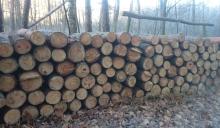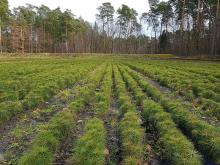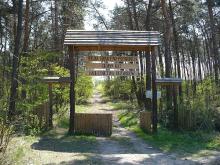 Asset Publisher
Asset Publisher
Polish forests
Poland is in the European lead, while concerning the area of all forests. They cover about 29,2 % of the country territory, and grow within the area of 9,1 million hectares. The overwhelming majority of the forests is state owned, of which almost 7,6 million hectares are managed by the State Forests National Forest Holding..
The number of Polish forest is still growing. The forestation rate of the country has increased from 21 % in 1945 to 29,2 % at the moment. Between 1995 and 2008, the forest area increased by 310 thousand ha. The basis for afforestation works is the "National Programme for Increasing the Forest Cover" (KPZL), assuming an increase of the forestation rate up to 30 % by 2020 and up to 33 % by 2050. Polish forests abound in flora, fauna and fungi. 65 % of the total number of animal species live there.
The forests grow in our country on poor soils, mainly because of the development of the agriculture in previous years. It influences the distribution of the types of the forest sites in Poland. Over 55 % of the forest areas is covered with coniferous forests. In other areas, there are forest sites, mainly the mixed ones. Their small part constitute alder and riparian forests – not more than 3 %.
In the years 1945 – 2011 the area of natural deciduous tree stands within the area of the State Forests National Forest Holding increased from 13 to 28,2 %.
Within the lowlands and uplands the most often occurring tee species is pine. It covers 64,3 % of the forest area of the State Forests National Forest Holding and 57,7 % of private and commune forests. In the mountains the predominant species is European spruce ( in the west) and European spruce with beech (in the east). Domination of pine is the result of carrying on sustainable forest management in the past. Once, the monocultures (crops or cultivations of one species) were the answer to the great demand of industry for wood. Such forests appeared to be quite fragile to climatic factors. They also were often the prey of pests' expansion.
In Polish forests, the share of other tree species, especially deciduous trees have been systematically increasing. The foresters have stepped aside from monocultures – that is why, they try to fit specific species of the forest stand to the natural stand, that would be proper for the given area. Thanks to that, in the years 1945 – 2011, the area of the deciduous tree stands within the lands of the State Forests National Forest Holding increased from 13 to 28,2 %. There occur more and more frequently the following tree species: oaks, ashes, maples, sycamore maples, elms, but also birches, beeches, alders, poplars, hornbeams, aspens, tilias and willows.
Our forests are the most often represented by the forest stands aged 40 to 80 years. The average age of the forest equals 60 years. More and more trees are of big size at the age over 80 years. Since the end of the Second World War, the forests' area has increased up to almost 1,85 million hectares.
Raport o stanie lasów w Polsce 2012
 Asset Publisher
Asset Publisher
Otwarci na nowe formy aktywności terenowej
Otwarci na nowe formy aktywności terenowej
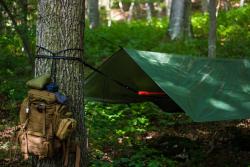 fot. pixabay.com
fot. pixabay.com
 fot. Obszary pilotażowego bushcraftu i survivalu na terenie Polski
fot. Obszary pilotażowego bushcraftu i survivalu na terenie Polski
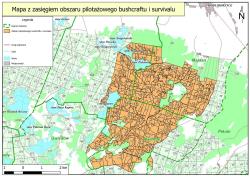 fot. Zasięg obszaru wyznaczonego na terenie Nadleśnictwa Janów Lubelski
fot. Zasięg obszaru wyznaczonego na terenie Nadleśnictwa Janów Lubelski
Z myślą o miłośnikach bushcraftu i survivalu rusza pilotażowy program Lasów Państwowych. Dzięki niemu pasjonaci tych nietypowych aktywności terenowych będą mogli uprawiać swoje hobby bez obaw o naruszenie prawa.
Do tego celu posłużą im specjalne obszary wyznaczone w kilkunastu regionach Polski na terenie leśnych kompleksów promocyjnych LP, których zadaniem jest m.in. testowanie innowacyjnych rozwiązań w zakresie gospodarki leśnej. Wśród przeszło 65 tys. ha powierzchni wytypowanych do projektu znalazł się także obszar zlokalizowany w granicach RDLP w Lublinie – w leśnych ostępach Lasów Janowskich.
Wybrany teren o powierzchni ponad 2,5 tys. ha znajduje się w północnej części Nadleśnictwa Janów Lubelski, w obrębie leśnictw Majdan, Kalenne i Stojeszyn. To fragment lasu pozbawiony infrastruktury rekreacyjno-turystycznej, oddalony od głównych dróg i miejsc o zwiększonym natężeniu ruchu. W tym ustronnym miejscu znajdującym się w sercu leśnej głuszy będzie można poczuć prawdziwą dzikość przyrody i bliskość natury.
Korzystanie z wyznaczonych powierzchni leśnych będzie możliwe w dowolnym miejscu znajdującym się w ich granicach, w maksymalnie czteroosobowej grupie i nie dłużej niż dwie noce z rzędu. Wystarczy uprzednie powiadomienie nadleśnictwa za pośrednictwem poczty elektronicznej. Biwakujący będą zobligowani do przestrzegania regulaminu, posprzątania miejsca w którym przebywali i przywrócenia do stanu w jakim go zastali. –Każdy z przybywających do obszarów pilotażowych powinien pamiętać o szacunku do przyrody, lasu i jego dzikich mieszkańców. Dlatego też korzystając z terenów leśnych należy mieć na względzie zasady odpowiedniego zachowania się w lesie i zgodnie z nimi postępować - tłumaczy zastępca dyrektora lubelskiej dyrekcji ds. gospodarki leśnej, dr inż. Mirosław Waniewski.
Nowatorski projekt jest dużym udogodnieniem i wyjściem naprzeciw wszystkim osobom, które w sposób niestandardowy korzystają z terenów leśnych będących pod zarządem Lasów Państwowych. Pilotażowy program potrwa do 23 listopada 2020 roku. W tym czasie leśnicy przekonają się czy takie formy aktywności jak bushcraft i survival nie tworzą zagrożeń dla lasu i innych osób.
Więcej informacji na stronie internetowej DGLP.


 fot. Paweł Fabijański
fot. Paweł Fabijański
 fot. Paweł Fabijański
fot. Paweł Fabijański
 fot. Paweł Fabijański
fot. Paweł Fabijański


